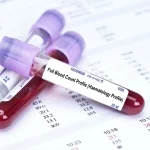G6PD deficiency
What is G6PD deficiency?
G6PD deficiency is a lifelong genetic disorder that causes your red blood cells to break down if you are exposed to certain foods, medicines or chemicals (triggers). People with G6PD deficiency are normally healthy but must avoid these triggers. Most people with G6PD deficiency are male.
The breakdown of red blood cells, called ‘haemolysis’, can lead to anaemia (lack of red blood cells) and jaundice (the yellowing of skin and eyes).
Certain triggers can cause your red blood cells to be destroyed faster than they can be replaced, known as acute haemolytic anaemia (AHA), which can be life-threatening.
Triggers can include:
- medicines such as some antibiotics, malaria, aspirin, some anti-cancer medicines and large doses of vitamin C
- some chemicals, including mothballs (naphthalene)
- some foods, particularly fava beans (broad beans), tonic water and blueberries
- certain infections
What are the symptoms of G6PD deficiency?
Most people with G6PD deficiency live without symptoms. If you are exposed to a trigger and go on to develop haemolytic anaemia, you may experience:
- dark-coloured urine (wee)
- yellow skin, eyes or tongue
- very pale skin
- a very fast heart rate and breathlessness
- low back pain
- fever
- diarrhoea, nausea and/or abdominal pain
What causes G6PD deficiency?
People with G6PD deficiency do not have enough of an enzyme called glucose-6-phosphate dehydrogenase (G6PD). This enzyme helps protects your red blood cells from damage.
G6PD deficiency is a lifelong genetic condition that is normally inherited through the female line. It is more common in males, and people with a Mediterranean, African, Asian, South American or Middle Eastern background.
When should I see my doctor?
Acute haemolytic anaemia needs medical attention. If you or your child develops jaundice (yellow skin and eyes), dark-coloured urine (wee), pale skin or lethargy, see your doctor as soon as possible.
How is G6PD deficiency diagnosed?
G6PD is diagnosed with a blood test. If you have symptoms, blood tests can also rule out other causes of your symptoms.
If one child in your family is diagnosed with G6PD deficiency, it’s a good idea to have your other children tested.
How is G6PD deficiency treated?
Most people do not need any treatment — they can manage their condition by avoiding the triggers. Your doctor will give you a list of things to avoid and tips to manage the condition.
If you develop anaemia, it will need to be treated. This sometimes involves a blood transfusion.
Babies with jaundice are usually treated with phototherapy (light therapy). This involves being placed under special lights. In severe cases, a treatment known as ‘exchange transfusion’ may be needed. This involves removing some of the your baby’s blood and replacing it with donor blood or plasma.
If you have a diagnosis of G6PD deficiency, tell your doctor about your condition, so they do not prescribe a medicine that could trigger the condition.
If you buy medicine without a prescription, talk to your pharmacist, tell them you have G6PD deficiency and read the label carefully. You should also be careful about using any herbal and alternative medicines, as some of these may also trigger acute haemolytic anaemia.
Having a virus or infection can stress the body and lead to haemolysis in people with G6PD deficiency. See your doctor if you or your child develops an infection.
Can G6PD deficiency be prevented?
G6PD deficiency can’t be prevented. It is a genetic condition that you are born with. Episodes of acute haemolytic anaemia can be prevented by avoiding triggers.
Complications of G6PD deficiency
The main complication of G6PD deficiency is acute haemolytic anaemia, which occurs after exposure to a trigger.
A common form of acute haemolytic anaemia is known as favism, which develops if a person with G6PD deficiency eats fava beans. After eating fava beans, acute haemolytic anaemia can develop rapidly. Symptoms of favism include the symptoms of AHA.
People with favism are always G6PD-deficient, but not all people with G6PD deficiency react this strongly to fava beans. Children are more likely to experience favism.


